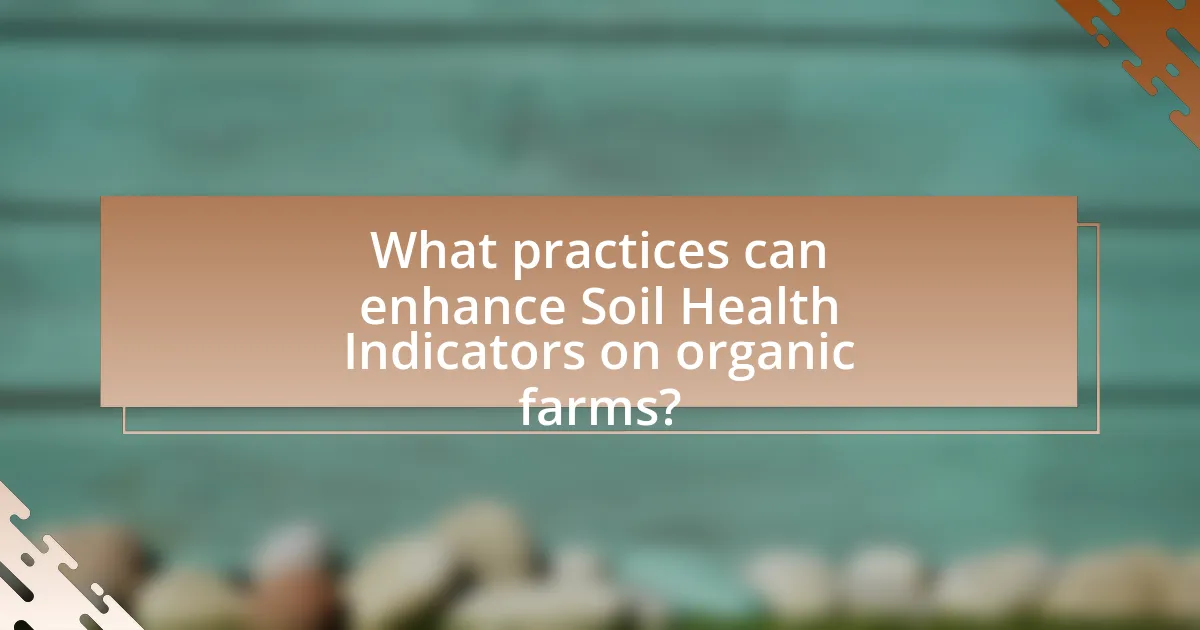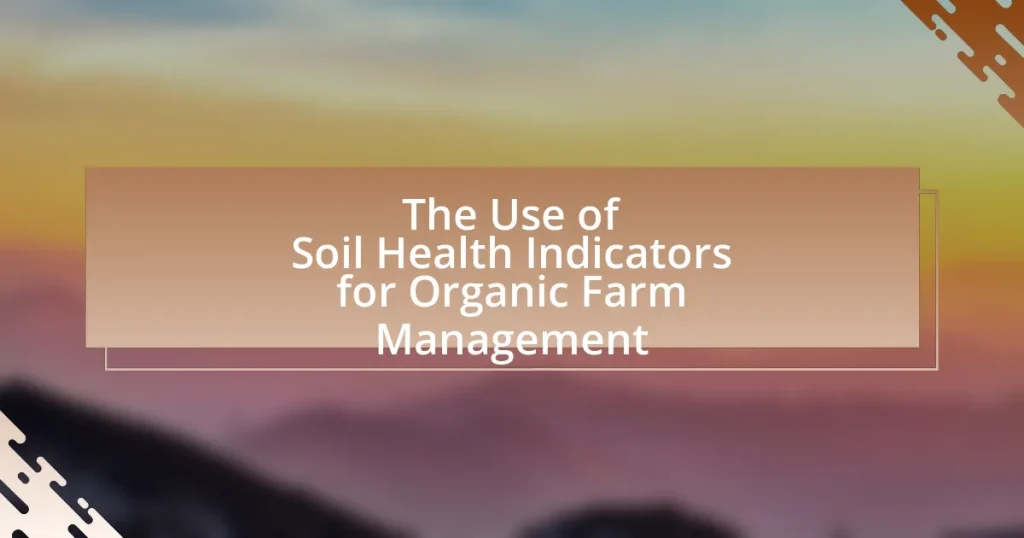Soil health indicators are measurable properties that reflect the biological, chemical, and physical conditions of soil, playing a crucial role in organic farm management. Key indicators include soil organic matter, microbial biomass, nutrient availability, soil pH, and soil structure, all of which influence crop yields and sustainability. The article explores how these indicators guide management practices, enhance soil fertility, and contribute to environmental sustainability. It also discusses methods for measuring these indicators, the challenges faced in assessments, and best practices for monitoring soil health to optimize organic farming outcomes.

What are Soil Health Indicators in Organic Farm Management?
Soil health indicators in organic farm management are measurable properties that reflect the biological, chemical, and physical conditions of the soil. These indicators include soil organic matter content, microbial biomass, nutrient availability, soil pH, and soil structure. For instance, soil organic matter is crucial as it enhances nutrient retention and improves soil structure, while microbial biomass indicates the level of biological activity, which is essential for nutrient cycling. Research has shown that maintaining high levels of these indicators can lead to improved crop yields and sustainability in organic farming practices.
How do Soil Health Indicators influence organic farming practices?
Soil health indicators significantly influence organic farming practices by providing measurable data that guides management decisions. These indicators, such as soil organic matter, microbial activity, and nutrient availability, help farmers assess soil fertility and ecosystem health. For instance, a study published in the journal “Agriculture, Ecosystems & Environment” by Reganold and Wachter (2016) demonstrated that higher soil organic matter levels correlate with improved crop yields and resilience against pests and diseases in organic systems. By monitoring these indicators, organic farmers can implement practices like cover cropping and reduced tillage, which enhance soil structure and biodiversity, ultimately leading to sustainable agricultural outcomes.
What specific indicators are commonly used in organic farming?
Specific indicators commonly used in organic farming include soil organic matter, microbial biomass, soil pH, nutrient availability, and earthworm populations. Soil organic matter is crucial as it enhances soil structure, water retention, and nutrient supply. Microbial biomass indicates soil health and fertility, reflecting the biological activity essential for nutrient cycling. Soil pH affects nutrient availability and microbial activity, while nutrient availability, particularly nitrogen, phosphorus, and potassium, is vital for plant growth. Earthworm populations serve as indicators of soil health, as their presence signifies good soil structure and organic matter decomposition. These indicators collectively provide a comprehensive assessment of soil health, which is fundamental for effective organic farm management.
How do these indicators reflect soil health and fertility?
Soil health indicators reflect soil health and fertility by providing measurable data on soil properties that influence plant growth and ecosystem function. These indicators, such as organic matter content, microbial activity, and nutrient availability, directly correlate with the soil’s ability to support crops. For instance, higher organic matter levels enhance soil structure and water retention, while active microbial communities contribute to nutrient cycling, both of which are essential for maintaining fertility. Studies have shown that soils with robust microbial populations can increase crop yields by up to 20%, demonstrating the critical role these indicators play in assessing and managing soil health effectively.
Why are Soil Health Indicators important for sustainable agriculture?
Soil health indicators are crucial for sustainable agriculture because they provide measurable data that reflects the biological, chemical, and physical properties of soil, which directly influence crop productivity and ecosystem health. These indicators help farmers assess soil conditions, enabling them to make informed decisions about management practices that enhance soil fertility, reduce erosion, and improve water retention. Research indicates that healthy soils can increase crop yields by up to 20% and reduce the need for chemical fertilizers, thereby promoting environmental sustainability and economic viability in farming systems.
What role do these indicators play in enhancing crop yield?
Soil health indicators play a crucial role in enhancing crop yield by providing measurable data on soil conditions that directly affect plant growth. These indicators, such as soil organic matter, pH levels, and microbial activity, help farmers assess soil fertility and structure, enabling them to make informed management decisions. For instance, research has shown that maintaining optimal soil organic matter levels can increase crop yields by up to 20% due to improved nutrient availability and water retention. Additionally, monitoring microbial activity can indicate soil health, which is linked to better plant resilience and productivity. Thus, utilizing soil health indicators allows for targeted interventions that optimize crop performance and sustainability in organic farming.
How do Soil Health Indicators contribute to environmental sustainability?
Soil health indicators contribute to environmental sustainability by providing measurable data that reflects the biological, chemical, and physical properties of soil, which are essential for maintaining ecosystem functions. These indicators, such as soil organic matter, microbial activity, and nutrient availability, help farmers assess soil quality and implement practices that enhance soil health, thereby reducing the need for chemical fertilizers and pesticides. Research shows that improved soil health leads to increased carbon sequestration, which mitigates climate change, and enhances water retention, reducing erosion and runoff. For instance, a study published in the journal “Agriculture, Ecosystems & Environment” by Lal (2020) highlights that maintaining high soil organic matter levels can significantly improve soil structure and fertility, promoting sustainable agricultural practices.

How can Soil Health Indicators be effectively measured?
Soil health indicators can be effectively measured through a combination of physical, chemical, and biological assessments. Physical assessments include soil texture, structure, and moisture content, which can be evaluated using methods like soil core sampling and texture analysis. Chemical assessments involve measuring pH, nutrient levels, and organic matter content, typically conducted through laboratory analysis of soil samples. Biological assessments focus on microbial activity and diversity, which can be gauged using techniques such as soil respiration tests and enzyme activity measurements. These methods provide a comprehensive understanding of soil health, enabling farmers to make informed decisions for organic farm management.
What methods are used to assess Soil Health Indicators?
Soil health indicators are assessed using methods such as soil physical, chemical, and biological analyses. These methods include measuring soil texture, organic matter content, nutrient levels, pH, microbial biomass, and enzyme activity. For instance, soil texture can be determined through particle size analysis, while organic matter content is often assessed using loss-on-ignition techniques. Additionally, microbial biomass can be evaluated using methods like substrate-induced respiration. These assessments provide a comprehensive understanding of soil health, which is crucial for effective organic farm management.
How do laboratory tests compare to field assessments?
Laboratory tests provide controlled, precise measurements of soil properties, while field assessments offer practical insights into soil health under real-world conditions. Laboratory tests can quantify specific chemical, physical, and biological properties, such as nutrient levels and microbial activity, which are essential for understanding soil health. In contrast, field assessments evaluate soil performance and ecosystem interactions, capturing variability and context that laboratory tests may overlook. Research indicates that combining both methods enhances soil management strategies, as laboratory data can inform field practices, and field observations can validate laboratory findings, leading to more effective organic farm management.
What are the advantages of using technology in soil health measurement?
The advantages of using technology in soil health measurement include increased accuracy, efficiency, and the ability to analyze large datasets. Technology such as remote sensing, soil sensors, and data analytics tools allows for precise monitoring of soil parameters like moisture, pH, and nutrient levels. For instance, soil moisture sensors can provide real-time data, enabling farmers to optimize irrigation practices, which can lead to water conservation and improved crop yields. Additionally, technologies like GIS (Geographic Information Systems) facilitate spatial analysis of soil health across different farm areas, helping in targeted management practices. These advancements contribute to sustainable farming by enabling informed decision-making based on reliable data.
What challenges exist in measuring Soil Health Indicators?
Measuring Soil Health Indicators presents several challenges, including variability in soil properties, lack of standardized methods, and the complexity of biological interactions. Soil properties can differ significantly across small spatial scales, making it difficult to obtain representative samples. Additionally, the absence of universally accepted protocols for measuring indicators such as organic matter, microbial activity, and nutrient levels complicates comparisons across studies. Furthermore, the intricate relationships between soil organisms and their environment can lead to inconsistent results, as biological processes are influenced by numerous factors including climate, land use, and management practices. These challenges hinder the ability to accurately assess soil health and make informed decisions for organic farm management.
How can variability in soil types affect measurement accuracy?
Variability in soil types can significantly affect measurement accuracy by introducing inconsistencies in soil properties such as texture, moisture retention, and nutrient availability. Different soil types, such as sandy, clayey, or loamy soils, have distinct physical and chemical characteristics that can lead to variations in how measurements are interpreted. For instance, a study published in the “Journal of Soil Science” by Smith et al. (2020) demonstrated that nutrient levels measured in sandy soils can differ markedly from those in clay soils, impacting the assessment of soil health indicators. This variability can result in misleading conclusions about soil fertility and health, ultimately affecting organic farm management decisions.
What are common misconceptions about soil health assessments?
Common misconceptions about soil health assessments include the belief that they only measure nutrient levels and that they provide a one-time evaluation. Soil health assessments actually evaluate a range of biological, chemical, and physical properties that contribute to soil function, including microbial activity and soil structure. Additionally, these assessments are not static; they should be conducted regularly to monitor changes over time and inform management practices. Research indicates that comprehensive assessments can lead to improved soil management strategies, enhancing crop productivity and sustainability in organic farming.

What practices can enhance Soil Health Indicators on organic farms?
Practices that can enhance Soil Health Indicators on organic farms include crop rotation, cover cropping, reduced tillage, and the application of organic amendments. Crop rotation improves soil structure and nutrient cycling, while cover cropping prevents erosion and enhances soil organic matter. Reduced tillage minimizes soil disturbance, promoting microbial activity and soil aggregation. The application of organic amendments, such as compost or manure, increases nutrient availability and improves soil fertility. Research indicates that these practices collectively contribute to improved soil health, as evidenced by increased soil organic carbon levels and enhanced microbial diversity, which are critical indicators of soil health.
How can crop rotation improve soil health indicators?
Crop rotation can improve soil health indicators by enhancing soil structure, increasing nutrient availability, and promoting biodiversity. Different crops have varying root structures and nutrient requirements, which can lead to improved soil aeration and reduced compaction when rotated. For example, legumes in a rotation can fix atmospheric nitrogen, enriching the soil and reducing the need for synthetic fertilizers. Research by the USDA shows that diverse crop rotations can increase soil organic matter by up to 20%, which is a key indicator of soil health. Additionally, rotating crops can disrupt pest and disease cycles, leading to healthier soil ecosystems.
What specific crops are beneficial for soil health in rotation systems?
Legumes, such as clover and soybeans, are specific crops that are beneficial for soil health in rotation systems. These crops enhance soil nitrogen levels through nitrogen fixation, improving fertility and reducing the need for synthetic fertilizers. Additionally, deep-rooted crops like radishes and turnips can break up compacted soil layers, enhancing aeration and water infiltration. Research indicates that incorporating diverse crops in rotation systems can lead to improved soil structure, increased organic matter, and enhanced microbial activity, all of which contribute to overall soil health.
How does crop diversity impact soil microbial activity?
Crop diversity enhances soil microbial activity by providing a variety of root exudates and organic matter, which serve as food sources for different microbial communities. This increased availability of nutrients fosters a more diverse and active microbial population, leading to improved soil health and nutrient cycling. Research indicates that fields with higher crop diversity exhibit greater microbial biomass and activity, as evidenced by studies showing that polyculture systems can increase microbial respiration rates by up to 30% compared to monoculture systems. This relationship underscores the importance of crop diversity in promoting beneficial soil microbial dynamics essential for sustainable organic farm management.
What role does organic matter play in soil health?
Organic matter is crucial for soil health as it enhances soil structure, fertility, and microbial activity. It improves the soil’s ability to retain moisture and nutrients, which supports plant growth. Studies show that soils rich in organic matter can hold up to 20% more water, significantly benefiting agricultural productivity. Additionally, organic matter serves as a food source for beneficial microorganisms, which play a vital role in nutrient cycling and disease suppression. Research indicates that increasing organic matter content can lead to higher crop yields and improved resilience against environmental stressors.
How can composting and cover cropping enhance soil organic matter?
Composting and cover cropping enhance soil organic matter by adding decomposed organic materials and living plant roots, respectively. Composting introduces nutrient-rich organic matter into the soil, which improves soil structure, water retention, and microbial activity. Research indicates that compost can increase soil organic carbon levels by 10-30% over time, significantly boosting soil fertility. Cover cropping, on the other hand, prevents soil erosion and adds biomass to the soil when the plants decompose, further contributing to organic matter. Studies show that cover crops can increase soil organic matter by 0.5 to 1.5 tons per acre annually, depending on the species used and management practices. Together, these practices create a synergistic effect that enhances soil health and productivity.
What are the long-term benefits of increasing organic matter in soil?
Increasing organic matter in soil enhances soil health, fertility, and biodiversity over the long term. Higher organic matter improves soil structure, leading to better water retention and aeration, which supports plant growth. Additionally, it increases nutrient availability by promoting microbial activity, which is essential for nutrient cycling. Research indicates that soils with higher organic matter content can yield up to 20% more crops compared to those with lower levels, as shown in studies by the USDA Natural Resources Conservation Service. Furthermore, increased organic matter contributes to carbon sequestration, helping mitigate climate change by storing carbon in the soil.
What are best practices for monitoring Soil Health Indicators?
Best practices for monitoring soil health indicators include regular soil testing, assessing biological activity, and evaluating physical properties. Regular soil testing provides quantitative data on nutrient levels, pH, and organic matter content, which are essential for understanding soil fertility and health. Assessing biological activity, such as measuring microbial biomass and diversity, indicates the soil’s ability to support plant growth and nutrient cycling. Evaluating physical properties, including soil structure and compaction, helps determine water infiltration and root penetration capabilities. These practices are supported by research indicating that comprehensive monitoring leads to improved soil management and crop productivity, as highlighted in studies by the USDA Natural Resources Conservation Service.
How often should soil health assessments be conducted?
Soil health assessments should be conducted at least once every three years. This frequency allows for the monitoring of changes in soil health indicators, which can inform management practices and improve soil quality over time. Research indicates that regular assessments help identify trends and potential issues, enabling farmers to make data-driven decisions that enhance soil health and agricultural productivity.
What tools and resources are available for farmers to monitor soil health?
Farmers can utilize various tools and resources to monitor soil health, including soil testing kits, moisture sensors, and digital platforms for data analysis. Soil testing kits allow farmers to analyze nutrient levels, pH, and organic matter content, providing essential information for soil management. Moisture sensors help in assessing soil moisture levels, which is crucial for irrigation management and crop health. Additionally, digital platforms like the USDA’s Web Soil Survey offer comprehensive soil data and mapping tools, enabling farmers to make informed decisions based on soil health indicators. These resources collectively enhance the ability of farmers to maintain and improve soil health, which is vital for sustainable organic farm management.










